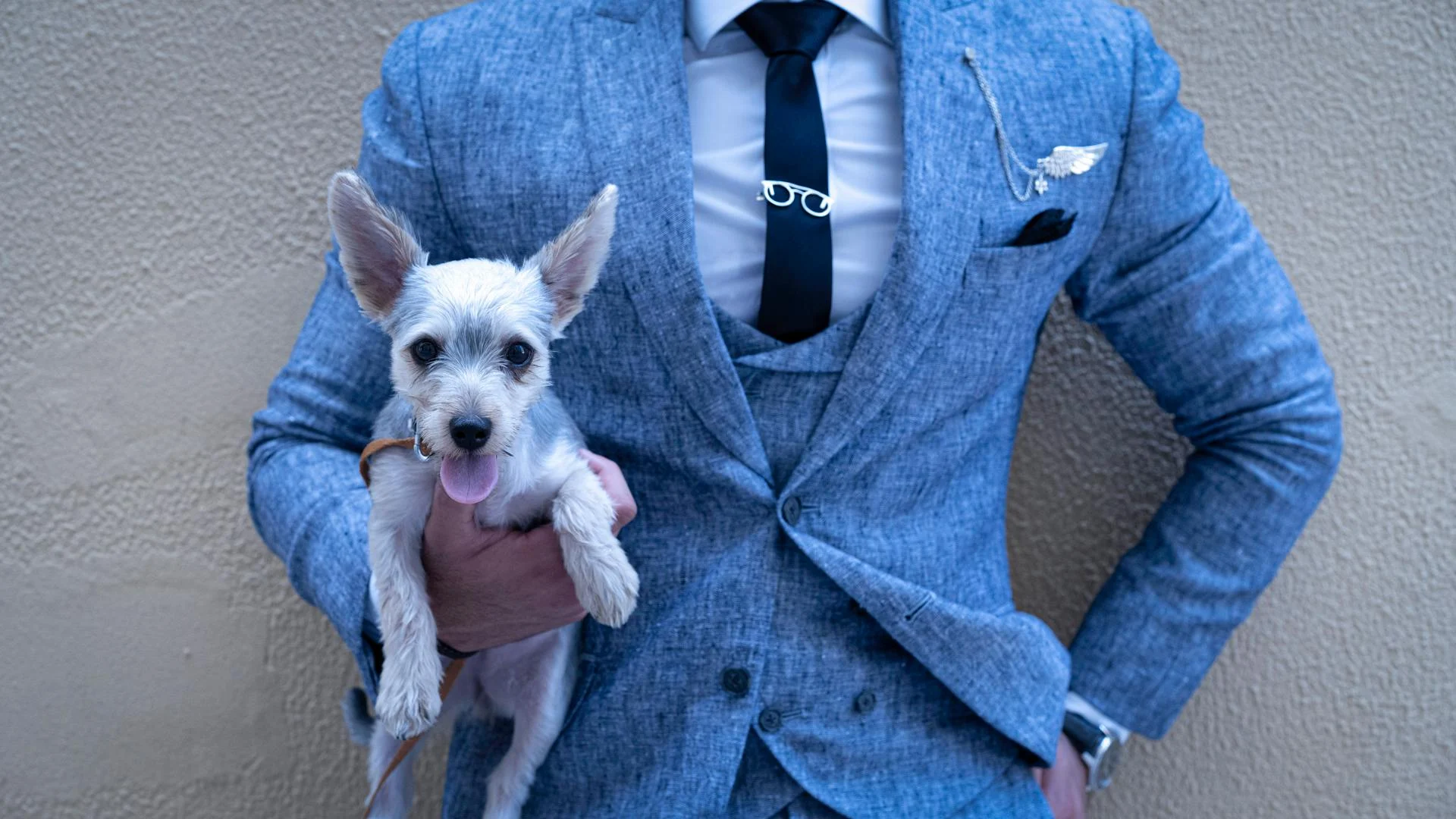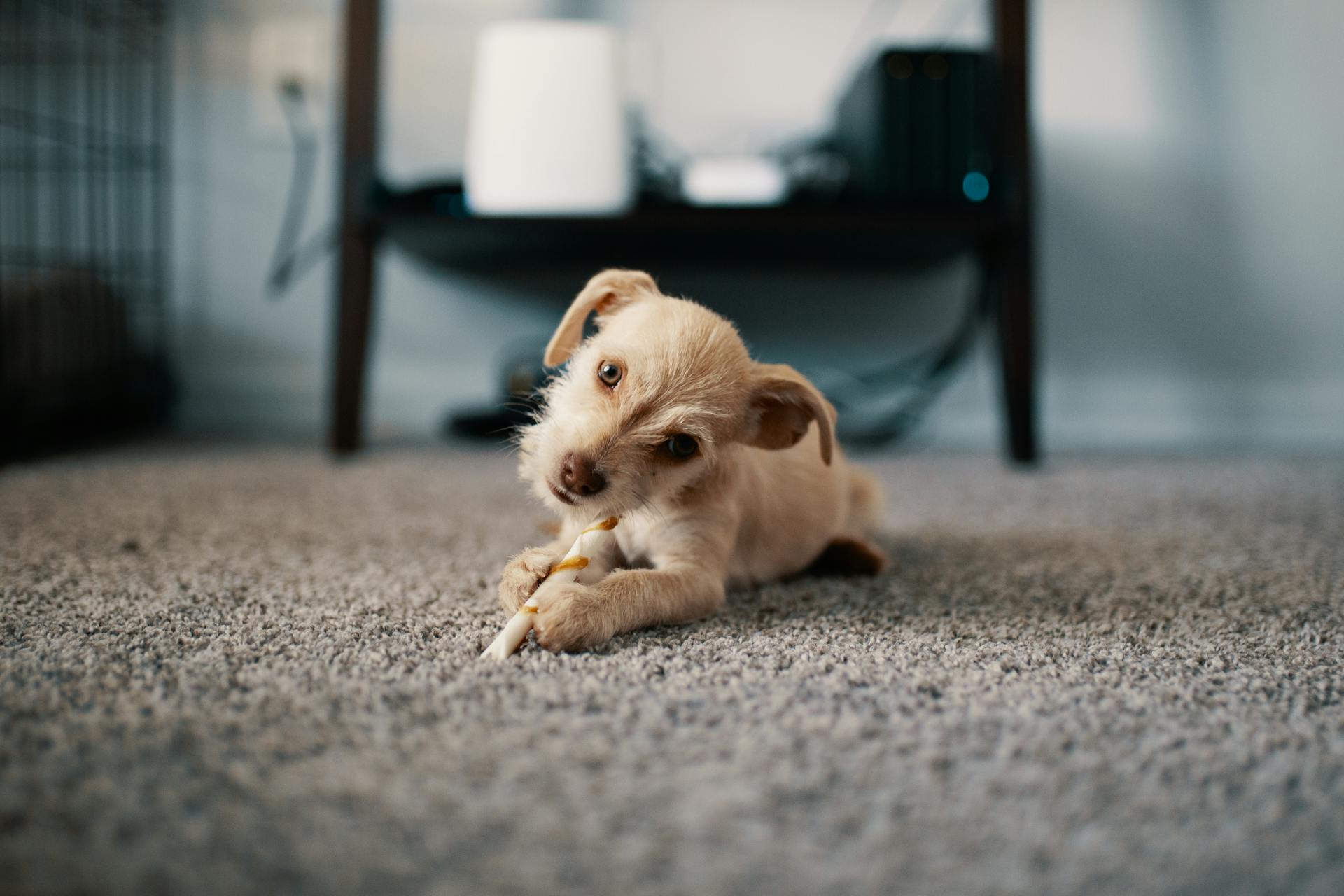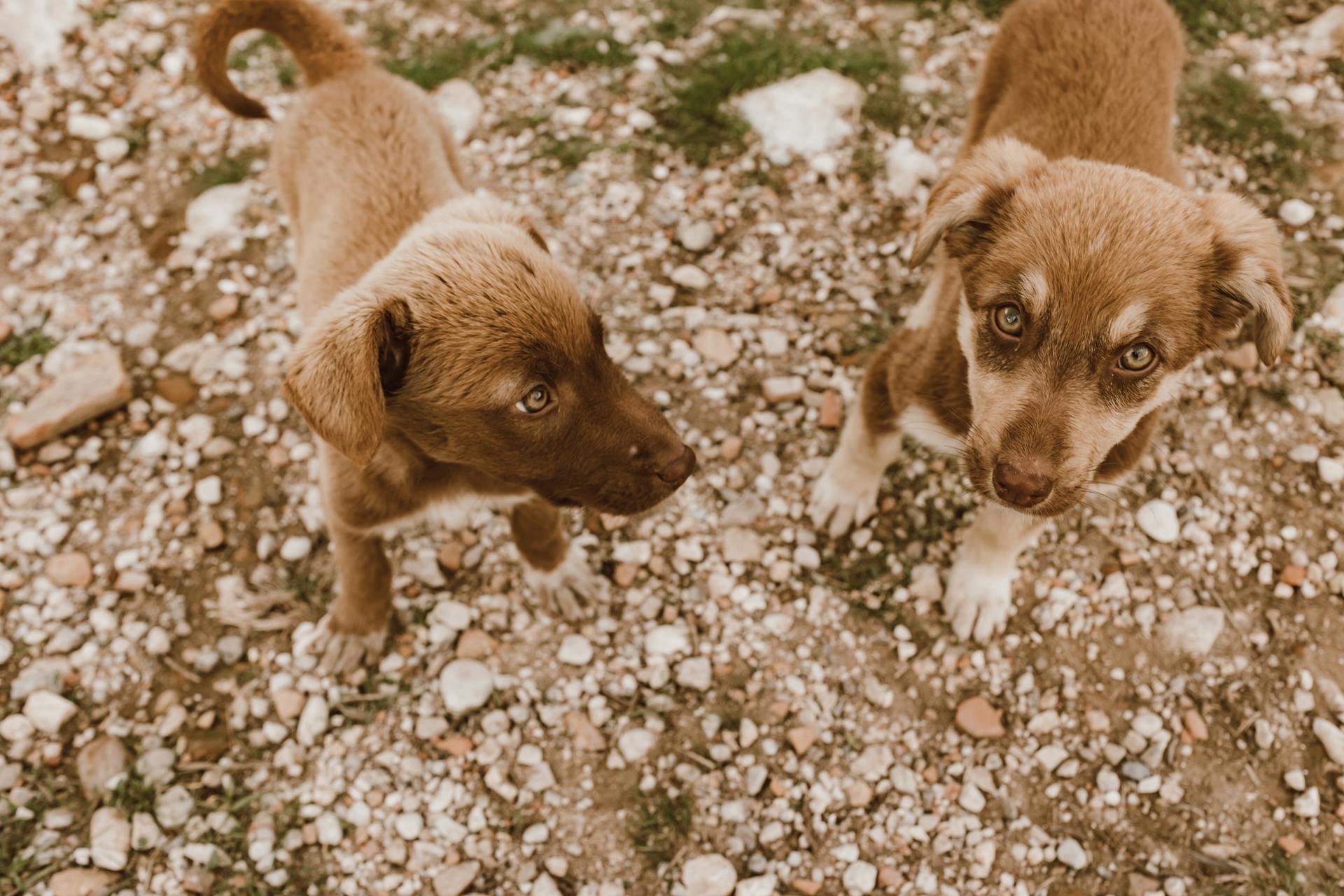
Separation anxiety in puppies is a common issue that can be distressing for both the pup and its owner. Puppies can become anxious when left alone, leading to destructive behavior and separation distress.
Puppies typically develop separation anxiety between 6 to 12 months of age. This is a critical period for socialization and training.
To manage separation anxiety, it's essential to establish a consistent daily routine that includes regular separation periods. Leaving a puppy alone for short periods, such as 5-10 minutes, can help it become comfortable with being separated from its owner.
Gradual separation is key to preventing separation anxiety in puppies. Start by leaving the room for short periods and return before the puppy becomes anxious.
Curious to learn more? Check out: Separation Anxiety Dogs Training
Separation Training Basics
Separation training for puppies can be a game-changer for anxious pups.
You can teach your puppy to overcome their fear using a behavioral psychology process called systematic desensitization. This involves introducing the thing that's scary at a level that's not scary.
Systematic desensitization works by gradually increasing the intensity of the scary stimulus while keeping your puppy relaxed. You'll need to figure out what distance is comfortable for your puppy from the trigger of their fear.
It's essential to watch your puppy's body language to control how long you're gone. This will help you determine when to start and stop training sessions.
Keep training sessions short and fun, and don't push your puppy too hard. As they get better, you can introduce more complex tasks and mix up the training regimen.
You'll know your puppy is making progress when they no longer exhibit anxious behaviors like whimpering, stiffening, or barking.
Broaden your view: How Long Do Puppies Cry When Crate Training
Preparation and Setup
Before you start separation training with your puppy, it's essential to set up a safe space for them to feel comfortable and relaxed. This can be a crate, a room with a baby gate, or a secure area.
To make this space a positive experience for your puppy, place a treat inside to encourage them to enter. If they go in on their own, reward them with more treats. You can also feed them in this space, put their toys in it during the day, and provide a selection of chews.
Place a tasty filled KONG in the safe space once a day, with you in close proximity, to help your puppy associate it with a positive experience. If your puppy seems disinterested in their chew, it may be a sign that you need to progress more slowly.
Training Techniques
Training your puppy to overcome separation anxiety requires patience and consistency. To start, think of it as teaching your puppy that nothing bad ever happens when you walk out the door.
Watch your puppy's body language to control how long you are gone, as excessive time away can exacerbate the issue. Up to 55 percent of dogs worldwide exhibit some kind of separation-related problem, so it's essential to tackle the issue before it becomes a problem.
Keep training as your puppy gets better by introducing departure-related objects one at a time, such as keys, jackets, or a purse. Mix up the training with easy and more complex tasks to keep your puppy engaged.
Systematic departure desensitization is a key technique in separation training. This involves slow exposure to the triggering stimulus, incrementally increasing how much time your puppy can tolerate being alone while remaining relaxed.
Commit to working on desensitization with your puppy for 20-30 minutes, 5 times a week, to see success. Desensitization to departures and isolation must be done sub-threshold, meaning your puppy should never be pushed into a state of panic.
You might like: Healthy Mind Canine - Separation Anxiety Training
Managing Stress and Frustration
Managing stress and frustration is crucial in separation training for puppies. It's not just about calming them down, but also about teaching them to handle frustration better.
Obedience training is helpful in separation anxiety because it teaches the dog to handle frustration by working through harder situations. This builds the ability to handle frustration, which comes from the inability to succeed, not from not overcoming obstacles.
Dogs get stressed when they can't predict the outcome of their behavior, so it's essential to be consistent in how we present material and ideas to them. If your dog is panting, yawning, salivating, pacing, or trembling, it's a sign they're too stressed, and you should back up and shorten the time you leave them alone until they're relaxed again.
See what others are reading: Dog Training Tips for Puppies
Adjustment Time
Creating a routine is key to helping your dog adjust to your departure. Give your dog time to adjust when you're leaving, and have consistent rituals to provide clarity.

Sitting down for 5 minutes before leaving can make a big difference. This allows your dog to process the fact that you're leaving.
When you're leaving outside your regular schedule, spend quality time with your dog beforehand. This can be as simple as playing with them or giving them a treat.
Here are some examples of activities you can do with your dog before leaving:
- Play with your dog for as long as it takes for them to be satisfied
- Give your dog a treat or a favorite toy to keep them occupied
- Take your dog for a short walk or playtime in the yard
The goal is to get your dog mentally tired and fulfilled, making it easier for them to calm down before you leave.
Restructuring the Relationship
Dogs crave clarity and understanding, and they need to have a reasonable expectation of how those around them will behave.
Not being consistent in how we present material, ideas, or what we want creates a lot of stress in dogs, as they can no longer predict the outcomes of their behavior.
Dogs do best when our relationship with them is clear, predictable, and consistent.
Signs of Stress
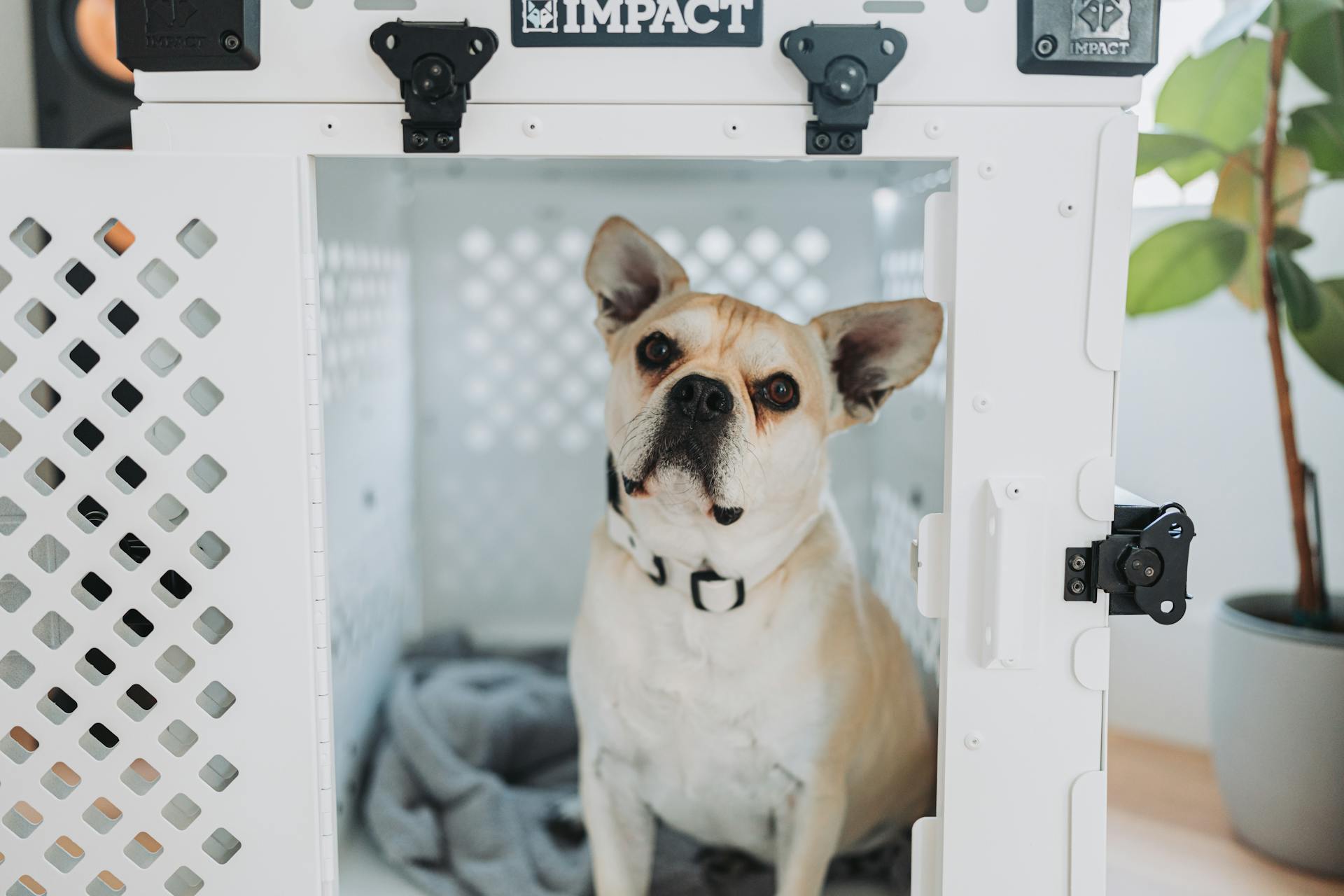
Recognizing the signs of stress is crucial to managing frustration and ensuring a positive experience for both you and your dog.
If your dog is panting, it's a clear indication that they're feeling overwhelmed.
Pacing is another common sign of stress in dogs, often accompanied by yawning or salivating.
Trembling can also be a sign that your dog is too stressed to continue.
Back up and shorten the time you leave your dog alone if you notice any of these signs, and wait until they're relaxed again before continuing.
Frustration
Frustration is a key component of separation anxiety in dogs, and it's triggered by the rage system, not just anxiety. This means that dogs become frustrated because they can't change their situation.
Frustration comes from the inability to succeed, not from not overcoming obstacles, which is a crucial distinction. It's not about being unable to achieve a goal, but about feeling like you're stuck.
Worth a look: Training Puppies Not to Bite
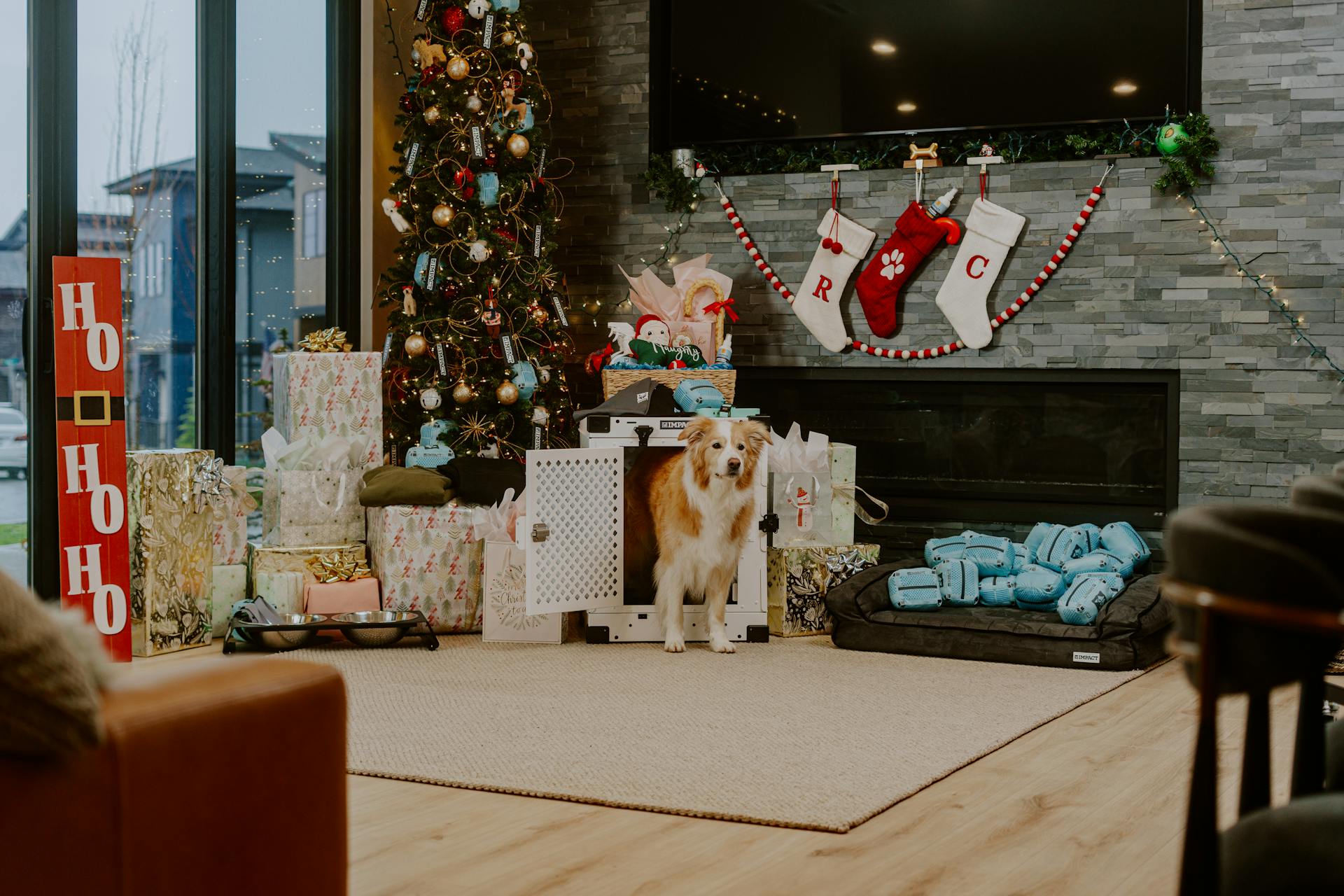
Obedience training can be helpful in managing frustration, as it teaches dogs to handle harder and harder situations, building their ability to work through challenges. This helps build confidence in the process.
In fact, frustration is a normal part of life, and it's not something to be ashamed of. By learning to handle frustration, dogs (and humans!) can build resilience and develop coping strategies.
Phase 1: Initial Training
Start by teaching your puppy to overcome their fear of being alone using systematic desensitization, a behavioral psychology process that involves introducing the thing that scares them at a level that's not scary.
Begin by determining how far away your puppy can be from the thing that causes their fear without feeling scared, and use that distance as your starting point for training.
Introduce departure-related objects one at a time, such as keys, jackets, or a purse, and mix up the training routine with easy and more complex tasks.
Watch your puppy's body language to control how long you are gone, as up to 55 percent of dogs worldwide exhibit some kind of separation-related problem.
Keep training sessions short and positive, and don't push your puppy past their comfort zone.
Start by having your puppy relax at a distance of 10 feet away from the thing that scares them, and gradually inch closer while monitoring their body language.
Phase 2: Duration
This phase is all about gradually increasing the amount of time your puppy is comfortable being left alone. At first, we add in seconds of alone time, but build up to multiple hours with your puppy snoozing away.
It's essential to remember that even when the problem is resolved, you should continue to teach your puppy gradually and positively, outside of the situation. Using a stuffed KONG or a nice chew can make the experience more positive.
Leave your puppy with a tasty KONG when you're leaving them, and try to make the experience as positive as possible. Your puppy should never be left for more than 4 hours on their own, and considerably less for a puppy and/or if in a crate.
Frequently Asked Questions
How to stop a puppy crying when you leave?
To minimize separation anxiety, leave a TV or radio on and consider hiring a dog walker or day care service. This can help distract your puppy and reduce crying when you're away.
How soon should puppies separate from their mother?
Puppies should be at least 8 weeks old before separating from their mother for a smooth transition to their new home. This minimum age ensures they receive essential socialization and care from their mother.
Sources
- https://happydogtraining.info/behavior/separation-anxiety-in-dogs/
- https://leaderofthepackdogtraining.org/helping-your-dog-through-separation-anxiety/
- https://www.thewildest.com/dog-behavior/separation-anxiety-training
- https://www.calmcanineacademy.com/blog/separation-anxiety-plan
- https://www.dogsforgood.org/good-advice/separation-anxiety/
Featured Images: pexels.com
